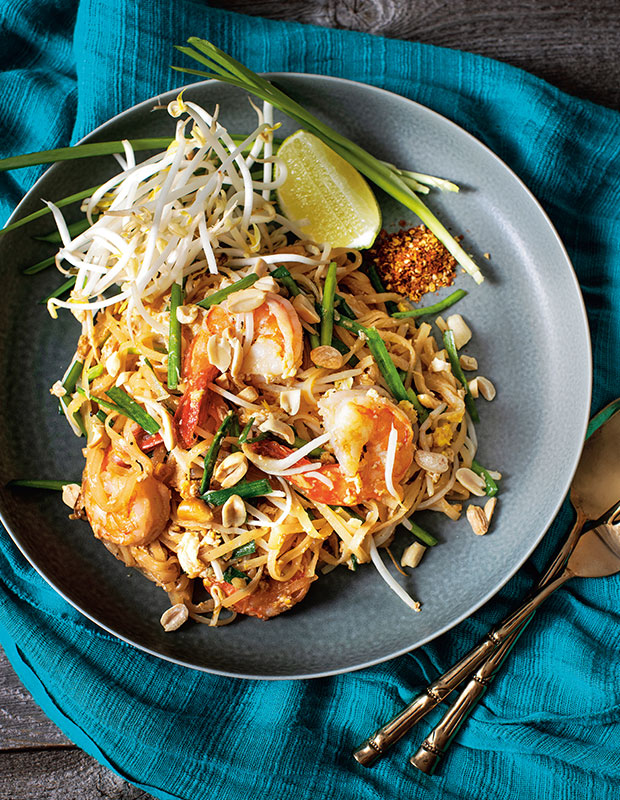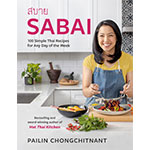Recipe
April 3, 2023
Minimalist Pad Thai

 “Traditional pad thai is quick to make but tedious to prep for. There are a lot of ingredients, some of which aren’t pantry staples even for Thai people. But that’s because pad thai is not a dish meant for home cooking—it’s something most people buy. But I wondered, what is the “minimum viable pad thai”? How much can I simplify it and still have it taste great and proudly be called pad thai? This is it right here. Faster, simpler, but still tastier than takeout. What I have removed are the dried shrimp, pressed tofu, and sweet preserved radish, and I’ve also provided a quick-soak method for the noodles. Everything that’s left I consider important, but the peanuts can go if you can’t eat them. You can find the recipe for my original pad thai on my website and in my first book, Hot Thai Kitchen.” – Pailin Chongchitnant
“Traditional pad thai is quick to make but tedious to prep for. There are a lot of ingredients, some of which aren’t pantry staples even for Thai people. But that’s because pad thai is not a dish meant for home cooking—it’s something most people buy. But I wondered, what is the “minimum viable pad thai”? How much can I simplify it and still have it taste great and proudly be called pad thai? This is it right here. Faster, simpler, but still tastier than takeout. What I have removed are the dried shrimp, pressed tofu, and sweet preserved radish, and I’ve also provided a quick-soak method for the noodles. Everything that’s left I consider important, but the peanuts can go if you can’t eat them. You can find the recipe for my original pad thai on my website and in my first book, Hot Thai Kitchen.” – Pailin Chongchitnant
Directions
Yield: Serves 2
Make Tamarind Paste
- Use your hands to pull apart the tamarind block into small chunks and place them in a large, heatproof mixing bowl.
- Pour the hot water over the tamarind and let it sit until it’s cool enough for you to handle, at least 20 minutes. You can let it sit for as long as you need at this point—the longer it sits, the easier the next step will be.
- Use your hand, preferably gloved if you don’t want tamarind stuck in your nails, to squeeze and scrunch the pulp to loosen it from the fibers. You should end up with something that has the consistency of a smoothie.
- Once you can feel that most of the pulp has been released from the fibers, strain the tamarind mixture into a pot through a sieve, but avoid a fine-mesh sieve, as the paste will be thick (Asian noodle strainers work great for this). Push as much of the liquid through as possible, and scrape the bottom of the sieve occasionally.
- Gradually pour about ½ cup (125 ml) room temperature water over the remaining fibers in the sieve while using your hand to mix it all around. This will rinse off any last little bit of tamarind still stuck in the fibers.
- You can use the tamarind paste right away for cooking, but for storage, cook it over medium-high heat until it boils, stirring constantly, because it is quite thick and can bubble and jump at you if you don’t stir. Allow it to bubble for 4 to 5 minutes to ensure that it is thoroughly heated through before turning off the heat.
- Transfer the hot tamarind paste to clean 1-cup (250 ml) mason jars. I like using the smaller ones so each jar will not be open for as long. Close the lids while the paste is still hot and let cool at room temperature before moving to the fridge for storage. You can also freeze the paste in ice cube trays and then store the cubes in freezer bags.
Make Sauce
- Melt the sugar in a small pot over medium-high heat. Once melted, let it cook for a bit longer, until the color becomes a deeper caramel but not quite dark brown. Once this color is achieved, immediately add the water; it will splatter aggressively and the sugar will harden. Turn the heat down to medium and swirl it around until most of the sugar is dissolved.
- Turn off the heat and stir in the tamarind paste and fish sauce. Don’t worry about a few stubborn chunks of sugar; they’ll have dissolved by the time you need the sauce.
Make Pad Thai
- Using scissors, cut the soaked noodles roughly in half so it’s easier to mix them with the veggies. Place all your prepped ingredients by the stove, ready to go.
- Place a wok or large nonstick skillet on high heat and pour in just enough oil to coat the bottom. Once the oil is very hot, lay the shrimp down in one layer and let them sear without moving them until at least halfway cooked, about 2 minutes. Flip and cook on the other side until they are done. Turn off the heat and transfer the shrimp to a bowl, leaving all the oil and any juices behind.
- Add a bit more oil to the pan if needed so that you have about 3 tablespoons (45 ml). Having enough oil is important to make sure that the noodles don’t clump together.
- Add the garlic and shallots, and turn the heat to medium. Stir until the shallots are translucent, about 2 minutes.
- Turn the heat up to the hottest it can go, and add the noodles and sauce. Toss together until most of the sauce has been absorbed. At this point it will look like there aren’t nearly enough noodles, but don’t panic, the dish will bulk up with the veggies and proteins.
- Push the noodles to one side of the pan to create space for the eggs, then break the eggs into the pan. Scramble slightly just to break the yolks, then move the noodles on top of the eggs and let the eggs continue to cook for another 30 to 45 seconds, until they are mostly cooked. Flip the noodles and then toss to break up the eggs.
- Give the noodles a quick taste to check their doneness. If they’re too chewy, add a splash of water and keep tossing for 1 minute or so to allow the water to absorb.
- Add the shrimp back to the pan, along with any juices, and toss to mix. Turn off the heat and add the bean sprouts, garlic chives, and half of the peanuts. Use tongs to mix just until everything is evenly distributed. Plate immediately—you want the bean sprouts to be as fresh as possible, so don’t let them linger in the hot pan unnecessarily.
- Top with the remaining peanuts and serve with wedges of lime. Add some roasted chili flakes for heat, if desired.
Janis Nicolay
Excerpted from Sabai by Pailin Chongchitnant. © 2023 Pailin Chongchitnant. Photographs by Janis Nicolay. Published by Appetite by Random House®, a division of Penguin Random House Canada Limited. Reproduced by arrangement with the Publisher. All rights reserved

